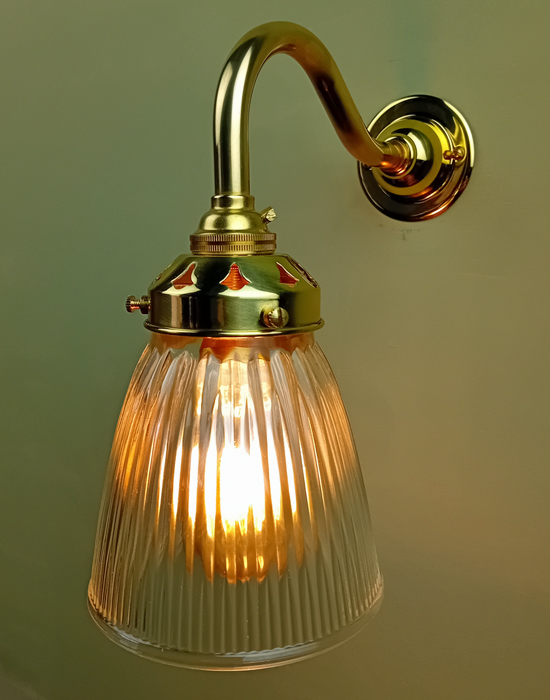




A beautifully simple wall light, inspired by an original Simplex design from the 1880s. Assembled with care using high-quality British and European components, this fixture stays true to its heritage while offering timeless appeal. The solid brass frame is available in a selection of finishes, including polished, acid-dipped antiqued, or nickel-plated, ensuring it complements a variety of interiors.
Fitted with the Lilliput shade, a finely crafted prismatic glass design, this light balances vintage charm with functional elegance. Its compact form provides a soft, diffused glow, ideal for creating a warm and inviting atmosphere. As with all our products, every component is fully recyclable, reinforcing our commitment to sustainability.
A refined wall light drawing inspiration from the elegant lighting styles of the late 19th century, this fixture is based on an original Simplex design and assembled with meticulous attention to detail using high-quality British and European components. The solid brass frame comes in a range of finishes, from polished or acid-dipped antiqued to nickel-plated, ensuring versatility to suit different interiors. The Lilliput shade, with its compact yet beautifully detailed prismatic glass, adds a touch of vintage charm while diffusing light evenly for a warm, inviting glow. As with all our products, every component is fully recyclable, reflecting our dedication to sustainability.
This wall light embodies a timeless aesthetic, evolving through history from an 18th-century candle sconce to gas lighting in the 19th century, and now as an elegant electric fixture for the modern era. Whether used as a classic downlighter or adapted as a subtle uplighter, its enduring appeal makes it a versatile choice. Each piece is expertly crafted in Birmingham or Northern Ireland, celebrating the finest in British and European craftsmanship.
The Lilliput shade, though petite in form, carries a strong design lineage. Inspired by the delicate yet functional glasswork of early gas lamps and prismatic designs from renowned makers like Holophane, it enhances both the aesthetic and practical aspects of the light, creating a balanced and atmospheric illumination.
Choose whether to mount the lamp in a traditional way on an oak backplate (or pateras) that you can wax and polish or paint as you wish, or mount the light without for a slightly more modern touch.
We recommend the use of modern LED bulbs and, if used, there is no restriction on its power. If old, filament (incandescent) bulbs are used then a maximum of 40w is recommended.
Prismatic Shades - 'Holophane'
During the early 1890s Andre Blondel, a French engineer and physicist, known for his work in electrical research and an attache to the Lighthouses and Beacons Service, and Spiridion Psaroudaki, a Greek engineer, conceived an idea in a Paris laboratory to cover a glass globe with horizontal glass prisms properly positioned to control light. Patents were awarded to the two inventors in Europe and, upon the granting of US Patent 563836 in 1893, an American, Otis A. Mygatt was introduced to this work. He saw the potential for both domestic and industrial lighting and began to collaborate with Blondel and Psaroudaki.
The advantages of prismatic shades very quickly became clear to a European public demanding brighter light. The prisms effectively focused the dim bulbs output to produce clear, bright, clean illumination and proved very popular in shops, schools, factories, lighthouses and homes. So much so that Mygatt bought the worldwide rights to Blondel and Psaroudaki's invention in 1894 and formed the Holophane Glass Company in 1898 in London to capitalise on his purchase. That same year Mygatt transferred the company to No.1 Broadway, New York.
The term 'Holophane' was derived from the Greek - 'Holos' and 'Phanein' - to contrive the meaning 'to appear completely luminous'. In 1900 Holophane was manufacturing a large range of globes and reflectors and described them thus: [they are made of] 'perfectly clear glass with prisms scientifically constructed in such a manner as to both direct the rays of light in downward and outward directions'.
Height: 23.5cm
Width: 11cm
Projection: 23.5cm